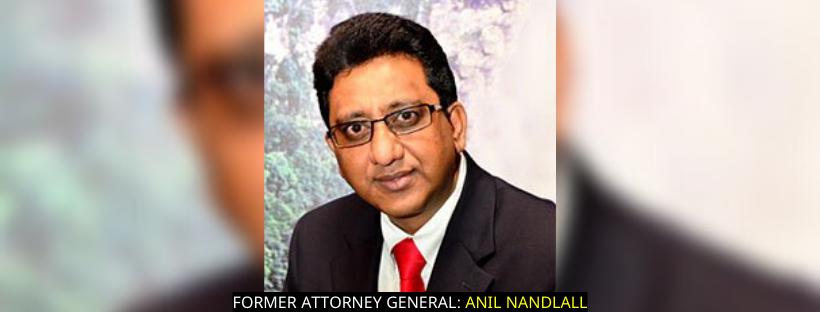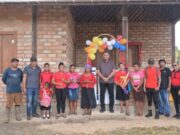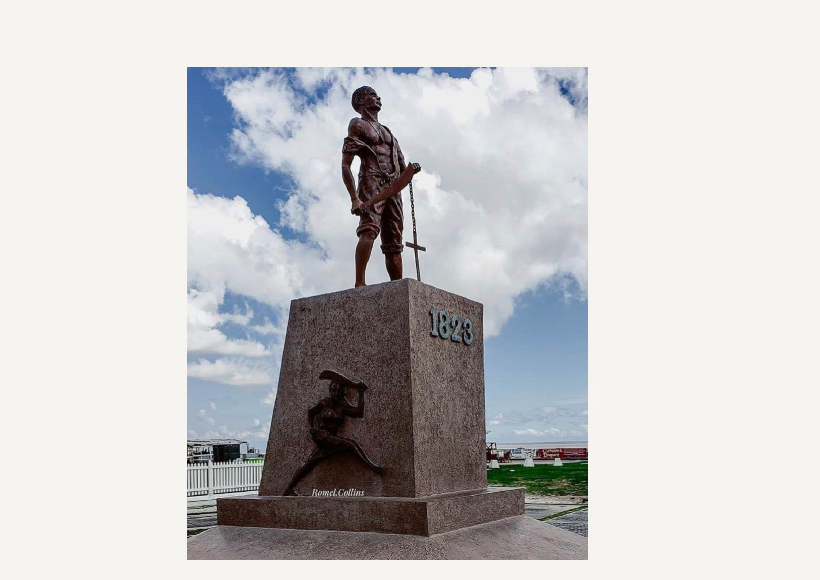The 1823 Monument was unveiled on August 5, 2013 by former President, Donald Ramotar. The monument was designed and built by US based Guyanese sculptor, Ivor Thom and is located along the Kitty Seawall Road opposite the Guyana Defence Force’s Camp Ayanganna Headquarters.
The monument features a bronze sculpture of what appears to be a male African slave wielding a machete and a chain with a cross attached to the end. The sculpture is mounted on a large concrete pedestal embedded with bronze sculptures, one male and one female, on both sides of the base.
Its location is ideal aesthetically since it can be found in the centre of a large plot of land, flanked on three sides by a white picket fence. The area surrounding the monument also appears garden like in nature, thus allowing it to stand out much better.
As with most, if not all monuments, there is a great representation by the 1823 monument which stands as a reminder of an important part of our country’s history.
The monument is representative of the slaves who lost their lives in the 1823 Demerara Slave Uprising. The 1823 rebellion was indeed historic as it was one of the catalysts for the abolishment of slavery.
The slaves who worked in Eastern Demerara were aggrieved due to the fact that they believed that their governor and masters were withholding their freedom from them. They were of the opinion that slavery was abolished in parliament and so felt that they had no other choice but to rise up against those who did not obey the King’s orders and claim what was rightfully theirs— freedom.
On the morning of August 17, 1823, a Sunday, slaves at Mahaica congregated at Plantation Success. Under the assumed leadership of Jack Gladstone, Joseph Packwood and Manuel, the plotting of an uprising began.
However, Quamina, Gladstone’s father, objected to a bloody revolt and proposed that they go on strike instead. When asked if guns were necessary, Quamina said that he would seek the counsel of the Reverend Smith.
After the Sunday service at Bethel Chapel in Le Ressouvenir, Quamina and two other slaves approached Smith and sought his advice. He rebuked the idea of an uprising and told them to be patient and await the new regulations.
Quamina made a promise to do just that but despite his efforts, the slaves were determined to rebel the following evening. The plan was to take all the guns on the plantations and lock up the Whites during the night and then send them to the Governor in the morning to bring the new law.
On the morning of August 18th, the plan was leaked by one of the house slaves to his master who then conveyed the message to the governor. He, along with a group of soldiers, rode up to Le Ressouvenir and La Bonne Intention and met with a large group of armed slaves. When he asked them what they wanted, they simply replied “our right.” He proposed to meet them at Plantation Felicity the next morning. They bluntly refused.
After being asked by Reverand Smith to desist, the slaves ignored him and continued with their initial plan. Some slaves avenged their harsh treatment and resorted to killing their masters while the majority aimed to keep their religious nature by remaining non-violent as Quamina had requested.
Because of the fear held by the Whites for their lives, the governor declared martial law. From then, the violence and killing escalated with the most prolific occurring in Bachelor’s Adventure where approximately 250 slaves were killed. After this, the uprising collapsed very quickly.
In the end, it resulted in the hanging of those instigating the uprising and an event that pushed for the abolishment of slavery.











